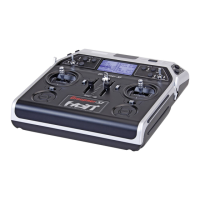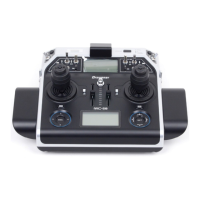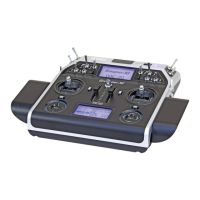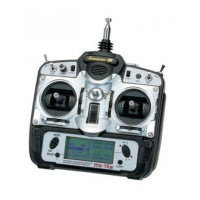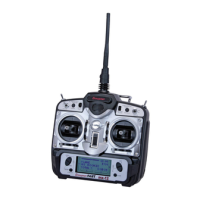167
Program description - Wing mixers
• Note that if two ap servos have been selected,
any transmitter control assigned to input 7 will be
decoupled in the software in order to avoid errors
in operating the aps. The same applies to input
10 if you select “2/4AIL 4FL” on the twelve-chan-
nel
mc-20 HoTT transmitter only.
• A range of options are available for positioning
aps. You can …
a) … simply accept one position per ight phase,
by setting only the corresponding trim values.
b) … vary the aps positioned by a) with a trans-
mitter control assigned to “Input 6” in the
»Control adjust« menu, page 112, and if de-
sired by also selecting ight-phase dependen-
cy “PH” in the “Type” column.
The selected transmitter control directly con-
trols the two ap servos located on receiver
outputs 6 and 7 and, as required, also the two
FL2 servos connected to outputs 9 and 10 – as-
suming that corresponding aps have been
specied on the “Aileron/camber aps” line in
the »Model type« menu. This transmitter con-
trol indirectly controls the ap position of the ai-
lerons via the percentage value entered in the
“AILE” (and “AIL2”) column on the “FLAP” line
of the multi-ap menu.
The two INC/DEC buttons, CTL 5 or 6, are vir-
tually ideal for this type of task, since their posi-
tion is automatically stored. These buttons are
tted on the
mc-20 HoTT transmitter only.
The particular advantage of these two trans-
mitter controls – especially if you select the
“PH” setting – lies in the fact that you can use
one and the same INC/DEC button as ap trim
controls in all the programmed ight phases,
but – in contrast to a position-related proportion-
al control – the trim values are retained even if
you switch models.
However, in order to improve control sensitivi-
its default value.
5. Complete the entry with a tap on the centre ESC
key of the left four-way button or the centre SET
key of the right four-way button.
Assigning switches
Wing mixers “AI RU” and “FL EL” can be made
optionally on/off switchable by way of a switch or ex-
panded switch. Accordingly, when the respective line is
selected, the familiar switch symbol (
) will appear on
the lower edge of the screen.
A switch can be assigned as described in the section
entitled “Physical control, switch and control switch as-
signments” on page 60.
Switching delays
The delay time or switch time configured on the
»Phase settings« menu, page 148, for the respective
flight phase also affects all wing mixers and thus avoids
abrupt changes to flap configurations when switching
between the flight phases.
Mixer neutral points (Offset)
For all mixers on the “Brake settings” sub-menu, the
“brake offset” to be set on the »Model type« menu is
to be configured to the transmitter control position at
which the airbrakes are retracted.
For this reason you should define which of the inputs 1,
7 or 8 you wish to use as the brake control, and enter
the appropriate offset, in the “Brake offset” line of the
»Model type« menu on the standard eight-channel
mc-16 HoTT transmitter, corresponding to your per-
sonal preference; see page 100. The same procedure
is used with the twelve-channel mc-20 HoTT trans-
mitter, with the exception that Input 9 is also available
as an alternative. When selecting “input 1”, please note
also that you may need to specify your desired “Throt-
tle min” position “forward/back” before establishing the
offset point in the “Motor at C1” line.
ty for ap settings, travel should be reduced to
about 25 % in “Input 6” line of the »Control ad-
just« menu.
c) … alternatively, you can also leave the default
entry of “0 %” in the “AILE” (and “AIL2”) column
on the “FLAP” line of the multi-ap menu, and
use the »Control adjust« menu to assign both
input 6 and input 5 to the same transmitter con-
trol. You can then set the degree to which both
ap pairs are affected, optionally making this
ight phase-dependent by selecting “PH” in the
“Type” column, with the respective travel ad-
justment.
Basic programming procedure
1. Select the desired line with the selection keys
of the left or right four-way button.
Depending on the line selected, the bottom line of
the display will either show the “Next page” (
)
icon or a switch icon.
2. Depending on the line selected, you will either
switch to the next page – on which you carry out the
same procedure as below – or the desired va lue field
is activated by tapping the centre SET key of the
right four-way button.
3. Use the selection keys to set the mixer ratio or de-
gree of differential.
To configure symmetrical mixer values, move the
transmitter control or stick to its centre position, so
that the marker frame surrounds both value fields.
To configure asymmetric values, move the transmit-
ter control/stick to the corresponding side.
Negative and positive parameter values are pos-
sible, in order to be able to adjust the respective
function to the direction of servo rotation or flap ori-
entation.
4. A simultaneous tap on the or keys of the
right four-way button (CLEAR) will reset the entry
value in the given active (inverse video) field back to

